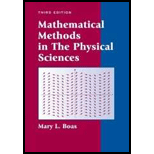1 Infinite Series, Power Series 2 Complex Numbers 3 Linear Algebra 4 Partial Differentitation 5 Multiple Integreals 6 Vector Analysis 7 Fourier Series And Transforms 8 Ordinary Differential Equations 9 Calculus Of Variations 10 Tensor Analysis 11 Special Functions 12 Series Solutions Of Differential Equations; Legendre, Bessel, Hermite, And Laguerre Functions 13 Partial Differential Equations 14 Functions Of A Complex Variable 15 Probability And Statistics expand_more
3.1 Introduction 3.2 Matrices; Row Reduction 3.3 Determinants; Cramer's Rule 3.4 Vectors 3.5 Lines And Planes 3.6 Matrix Operations 3.7 Linear Combination, Linear Functions, Linear Operators 3.8 Linear Dependence And Independence 3.9 Special Matrices And Formulas 3.10 Linear Vector Spaces 3.11 Eigenvalues And Eigenvectors; Diagonalizing Matrices 3.12 Application Of Diagonalization 3.13 A Brief Introduction To Groups 3.14 General Vector Spaces 3.15 Miscellaneous Problem expand_more
Problem 1P: Verify 11.7. Also verify 11.12 and find the corresponding different C in 11.11. Hint: To find C,... Problem 2P: Verify that the two eigenvectors in 11.8 are perpendicular, and that C in 11.10 satisfies the... Problem 3P: If C is orthogonal and M is symmetric, show that C1MC is symmetric. If C is orthogonal and M... Problem 4P: Find the inverse of the rotation matrix in 7.13; you should get C in 11.14. Replace by in 7.13 to... Problem 5P: Show that the C matrix in 11.10 does represent a rotation by finding the rotation angle. Write... Problem 6P: Show that if C is a matrix whose columns are the components x1,y1 and x2,y2 of two perpendicular... Problem 7P: Generalize Problem 6 to three dimensions; to n dimensions. Problem 8P: Show that under the transformation 11.1, all points x,y on a given straight line through the origin... Problem 9P: Show that detC1MC=detM. Hints: See 6.6. What is the product of C1 and det C? Thus show that the... Problem 10P: Show that TrC1MC=TrM. Hint: see (9.13). Thus show that the sum of the eigenvalues of M is equal to... Problem 11P: Find the inverse of the transformation x=2x3y,y=x+y, that is, find x, y in terms of x,y. (Hint: Use... Problem 12P: Find the eigenvalues and eigenvectors of the following matrices. Do some problems by hand to be sure... Problem 13P: Find the eigenvalues and eigenvectors of the following matrices. Do some problems by hand to be sure... Problem 14P: Find the eigenvalues and eigenvectors of the following matrices. Do some problems by hand to be sure... Problem 15P: Find the eigenvalues and eigenvectors of the following matrices. Do some problems by hand to be sure... Problem 16P: Find the eigenvalues and eigenvectors of the following matrices. Do some problems by hand to be sure... Problem 17P: Find the eigenvalues and eigenvectors of the following matrices. Do some problems by hand to be sure... Problem 18P: Find the eigenvalues and eigenvectors of the following matrices. Do some problems by hand to be sure... Problem 19P: Find the eigenvalues and eigenvectors of the following matrices. Do some problems by hand to be sure... Problem 20P: Find the eigenvalues and eigenvectors of the following matrices. Do some problems by hand to be sure... Problem 21P: Find the eigenvalues and eigenvectors of the following matrices. Do some problems by hand to be sure... Problem 22P: Find the eigenvalues and eigenvectors of the following matrices. Do some problems by hand to be sure... Problem 23P: Find the eigenvalues and eigenvectors of the following matrices. Do some problems by hand to be sure... Problem 24P: Find the eigenvalues and eigenvectors of the following matrices. Do some problems by hand to be sure... Problem 25P: Find the eigenvalues and eigenvectors of the following matrices. Do some problems by hand to be sure... Problem 26P: Find the eigenvalues and eigenvectors of the following matrices. Do some problems by hand to be sure... Problem 27P: Let each of the following matrices M describe a deformation of the x,y plane. For each given M find:... Problem 28P: Let each of the following matrices M describe a deformation of the x,y plane. For each given M find:... Problem 29P: Let each of the following matrices M describe a deformation of the x,y plane. For each given M find:... Problem 30P: Let each of the following matrices M describe a deformation of the x,y plane. For each given M find:... Problem 31P: Let each of the following matrices M describe a deformation of the x,y plane. For each given M find:... Problem 32P: Let each of the following matrices M describe a deformation of the x,y plane. For each given M find:... Problem 33P: Find the eigenvalues and eigenvectors of the real symmetric matrix M=AHHB. Show that the eigenvalues... Problem 34P: By multiplying out M=CDC1 the diagonal matrix where C is the rotation matrix 11.14 and D is 1002,... Problem 35P: The characteristic equation for a second-order matrix M is a quadratic equation. We have considered... Problem 36P: Verify the eigenvalues and eigenvectors of matrix M in 11.20. Find some other pairs of orthogonal... Problem 37P: Starting with 11.23, obtain 11.24. Hints: Take the transpose conjugate (dagger) of the first... Problem 38P: Verify equation 11.25. Hint: Remember from Section 9 that the transpose conjugate (dagger) of a... Problem 39P: Write out the detailed proof of 11.27. Hint: Follow the proof of 11.26 in equations 11.21 to 11.25,... Problem 40P: Verify the details as indicated in diagonalizing H in (11.29). Problem 41P: Verify that each of the following matrices is Hermitian. Find its eigenvalues and eigenvectors,... Problem 42P: Verify that each of the following matrices is Hermitian. Find its eigenvalues and eigenvectors,... Problem 43P: Verify that each of the following matrices is Hermitian. Find its eigenvalues and eigenvectors,... Problem 44P: Verify that each of the following matrices is Hermitian. Find its eigenvalues and eigenvectors,... Problem 45P: Verify the details in the discussion of the matrices in 11.31. Problem 46P: We have seen that an orthogonal matrix with determinant 1 has at least one eigen- value =1, and an... Problem 47P: Find a unitary matrix U which diagonalizes A in 11.31 and verify that U1AU is diagonal with the... Problem 48P: Show that an orthogonal matrix M with all real eigenvalues is symmetric. Hints: Method 1. When the... Problem 49P: Verify the results for F in the discussion of 11.34. Problem 50P: Show that the trace of a rotation matrix equals 2cos+1 where is the rotation angle, and the trace... Problem 51P: Show that each of the following matrices is orthogonal and find the rotation and/or reflection it... Problem 52P: Show that each of the following matrices is orthogonal and find the rotation and/or reflection it... Problem 53P: Show that each of the following matrices is orthogonal and find the rotation and/or reflection it... Problem 54P: Show that each of the following matrices is orthogonal and find the rotation and/or reflection it... Problem 55P: Show that each of the following matrices is orthogonal and find the rotation and/or reflection it... Problem 56P: Show that each of the following matrices is orthogonal and find the rotation and/or reflection it... Problem 57P: Show that if D is a diagonal matrix, then Dn is the diagonal matrix with elements equal to the nth... Problem 58P: Note in Section 6 [see (6.15)] that, for the given matrix A, we found A2=I, so it was easy to find... Problem 59P: Repeat the last part of Problem 58 for the matrix M=3113. Note in Section 6 [see (6.15)) that, for... Problem 60P: The Caley-Hamilton theorem states that A matrix satisfies its own characteristic equation. Verify... Problem 61P: At the end of Section 9 we proved that if H is a Hermitian matrix, then the matrix eiH is unitary.... Problem 62P: Show that if matrices F and G can be diagonalized by the same C matrix, then they commute. Hint: Do... format_list_bulleted


 Elementary Linear Algebra (MindTap Course List)AlgebraISBN:9781305658004Author:Ron LarsonPublisher:Cengage Learning
Elementary Linear Algebra (MindTap Course List)AlgebraISBN:9781305658004Author:Ron LarsonPublisher:Cengage Learning Linear Algebra: A Modern IntroductionAlgebraISBN:9781285463247Author:David PoolePublisher:Cengage Learning
Linear Algebra: A Modern IntroductionAlgebraISBN:9781285463247Author:David PoolePublisher:Cengage Learning
